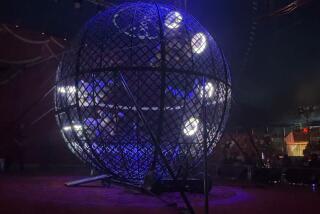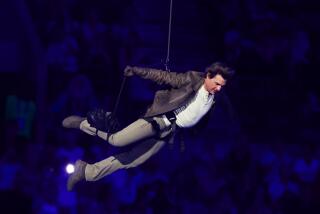CIRCUS REVIEW : The <i> Other</i> Greatest Show on Earth
- Share via
Some friends went to the Moscow Circus in Moscow last spring and were disappointed. They should catch the road company.
What we have at the Inglewood Forum is a distillation of some of the best circus acts in the Soviet Union--which is to say, some of the best circus acts in the world. In the European tradition, there’s only one ring. But it is filled with interest.
We understate, for emphasis. It’s more than interesting when Nikolai Pavlenko sends his 17 Sumatran tigers jumping through a flaming hoop. It’s thrilling, like some kind of primitive rite that mankind is supposed to have progressed beyond. Not that far.
Being a Russian show, there is a bear act, directed by Vladislav Zolkin and his wife Svetlana Mikityuk. What’s startling here isn’t the tricks that the bears have learned to do. Somehow, one expected that. But one didn’t expect to see the bears handing the props around. Does everybody go out for coffee after the show?
The Mednikov-Abakarov high-wire act has a man carrying four beautiful young women on his shoulders 30 feet over the ring. Since I was seated halfway up in the arena, at the exact level of their platform, I couldn’t feel the trepidation, but I did get a close-up view of their technique. There is no great trick to walking on a wire. Given total concentration, extreme sensitivity to one’s partner and a superb physique, anybody could do it.
A later aerial act inspired something like awe. This was an flying ballet entitled “The Cranes.” At its center is a trapeze act with the classic swings and catches, magnificently done. (We talk about “the illusion of the first time” in acting. In trapeze work, it’s always the first time.)
But the beginning and end of this act go beyond classic trapeze work. They are an aerial poem dedicated to the memory of Soviet soldiers fallen in World War II--the cranes (as in the Soviet film “The Cranes Are Flying.”)
The white-clad performers zoom to the top of the arena as if sent from a slingshot, and then take long, swooning dives into the net, crisscrossing as they go, like angels at play. Eerie, beautiful stuff.
That will be followed by a clown, Semyon Margulyan, who gets the people at ringside involved in a silly bell-ringing act. “The bells up, please! Yes--more up! Upper!” Or by a juggler, Alexander Frish, who claps together 17 bricks in a row, making the kids count them aloud. “Smile! Speak out!”
This circus knows when to go into the air and when to stay on the ground. And its clowns have common sense. Margulyan and his partner, Igor Podchufarov, get into a jumping contest. Who can jump the highest over a length of tape?
The tape keeps getting posted higher and higher until it’s so high that anybody who tried to jump over it would look like a fool. I won’t disclose the solution, but it involves a pair of scissors. These clowns are philosophers as well as comics.
The finale is a real flag-waver, the flags representing both the United States and the Soviet Union. It’s a heartening image at the end of a troubled decade. But this isn’t a show with a message. It’s as much fun as a circus.
More to Read
Sign up for Essential California
The most important California stories and recommendations in your inbox every morning.
You may occasionally receive promotional content from the Los Angeles Times.










